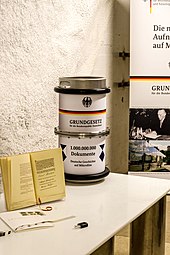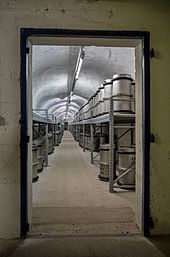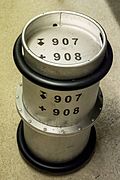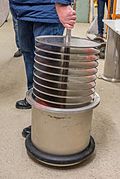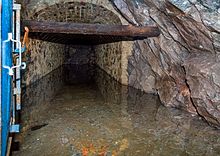Barbarastollen

The Barbarastollen , also known as the Oberriedstollen or Oberrieder Stollen , is a disused supply gallery - overburden tunnels for silver and ores - of the former mine in Hörnergrund at the foot of the Schauinsland near Oberried near Freiburg im Breisgau . It is the central salvage location of the Federal Republic of Germany for the storage of photographically archived documents of great national or cultural historical importance - in black and white on 35 millimeter polyester thin film and since 2010 also on color film. It is the largest archive for long-term archiving in Europe . The tunnel is named after St. Barbara of Nicomedia , the patron saint of miners.
history
The Barbarastollen was excavated in 1903, with a planned length of around 3500 m it was supposed to create a connection to the Roggenbach shaft of the Schauinsland pit . It was supposed to bring material and ore from the shaft to a train station planned in Hintertal. It was carved into the mountain up to a length of 700 m, but was neither completed nor used as a transport tunnel. The last visit to the tunnel took place in October 1954.
From 1972 to 1974 renovations took place gradually. In 1975 the first microfilms were stored, previously the archive films were stored at the individual filming locations.
Since April 24, 1978, the Barbarastollen has been the only object in Germany to be subject to special protection under the rules of the Hague Convention for the Protection of Cultural Property in the Event of Armed Conflict and is therefore entered in the International Register of Objects under Special Protection at UNESCO in Paris . The special status of this place is indicated by the three-fold blue and white cultural property protection symbol at the tunnel entrance.
The location and function of the bunker were only officially announced after the east-west relaxation.
On October 3, 2016 ( Day of German Unity ), container 2165 was stored in a special storage facility; it contains the Basic Law as the billionth recording of the archiving project. In the presence of the President of the Federal Office for Civil Protection and Disaster Aid (BBK), Christoph Unger , the Basic Law of the Federal Republic of Germany and the complete set of the associated files were stored. This includes the original documents of the first version with the signatures of the members of the Parliamentary Council chaired by Konrad Adenauer . This set of documents was filmed by the Landesarchiv Berlin and comprises around 30,000 pages.
administration

The 2001 Federal Office of Administration as a central office for civil defense risen Federal Office of Civil Defense was his lecture Cultural Property in charge from the beginning of the tunnel. Since it was founded in 2004, the Federal Office for Civil Protection and Disaster Aid (BBK), based in Bonn , has been responsible, among other things, for measures to secure cultural property. It continues to use the tunnel as a safe place to keep the archival material from Germany copied on film rolls .
Technical
The main tunnel is 680 m long, but the archive material is not archived there, but in two storage tunnels. These two storage tunnels are at 340 m and 390 m from the mouth hole and have a minimum cover of 200 m of rock over the tunnels in the storage area. The tunnel system is completely made of granite and gneiss . The storage tunnels are each 50 m long, 3 m high and 3.40 m wide. They are carved into the mountain, lined with formwork concrete and secured with standard pressure doors. The doors are fitted with high-quality mechanical safe locks so that they can be opened and closed without electricity. The rooms are not air-conditioned , but because of their location they have a temperature of 10 ° C and a relative humidity of 75%. Shortly after the access to the second storage tunnel, the main tunnel is barred. The stretch behind it is in its original condition, after 350 m the old mine is sealed with a concrete plug.
In the storage tunnels there are more than 2000 hermetically sealed stainless steel containers ( V2A ) (as of October 2016), which are stored on two-story shelves.
Two types of containers are used: The older, smaller containers are welded. Since rust had formed on these over time, they were moved to the more modern containers. These containers are deep-drawn and without welds. For filling, the containers are stored for four weeks at 10 ° C and 35% humidity before they are closed. This procedure assumes a durability of the film material of at least 500 years without loss of information. All regular archive material has now (as of October 3, 2016) been relocated to the newer type 2 containers, which means that space has been created again in the archive tunnel. The tunnel is secured against unauthorized access through extensive, mutually monitoring alarm systems as well as multiple personnel access controls.
| Type 1 (old) | Type 2 (new) | |
|---|---|---|
 |
||
| Manufacturer | Hoesch AG | Primetall GmbH |
| Container type | small | big |
| shape | cylindrical | cylindrical |
| execution | welded | seamless deep-drawn |
| material | Stainless steel V2A | Stainless steel V2A |
| poetry | copper | copper |
| Clasp | 16 screws | 16 screws |
| height | 65 cm | 78 cm |
| diameter | 28 cm | 43 cm |
| Empty weight | 25 kg | 42 kg |
| Weight filled | approx. 70 kg | approx. 120 kg |
| volume | 15 rolls of 760 m | 16 rolls of 1520 m |
| Volume filmmeter, thickness 7/100 mm, width 35 mm polyester material |
11,400 m | 24,320 m |
| Volume pictures | approx. 410,400 | approx. 875.520 |
As a result of the fire in the Duchess Anna Amalia Library in Weimar, a new archiving technology called "ArchiveLaser" was developed at the Fraunhofer Institute for Physical Measurement Technology in Freiburg as part of the InnoNet program ARCHE, which will also be used to store color films in the future can. For this purpose, the long-term stable microfilm ILFOCHROME® MICROGRAPHIC is exposed with a laser. This film is 250 times less sensitive than normal photo films and has a resolution with which 25 A4 pages can be exposed on an image of 45 × 32 mm. The pixel size is 3 micrometers; thus the number of pixels is 10,000 × 15,000. In contrast to slide film, this film consists of pure azo dyes without silver and, like black and white archive films, has a polyester carrier. These color films have been stored since 2010.
Goods to be stored
Copies of the handwritten works of the great German composers and writers as well as of historical documents and contracts are stored in the Barbarastollen. The documents kept include, for example:
- A certificate from Emperor Charlemagne in favor of the St. Emmeram Monastery in Regensburg from 794 (it is said to be the oldest document in storage)
- Otto the Great's coronation certificate from 936
- Albertus Magnus' commentary on the Gospel of Matthew
- the Golden Bull (Bulla Aurea) from 1356
- the Cologne composite letter of 1396
- the bull threatening excommunication (Exsurge Domine) of Pope Leo X against Martin Luther on June 15, 1520
- the construction plans of the Cologne Cathedral
- Manuscripts by the composer Johann Sebastian Bach
- the text of the Treaty of the Peace of Westphalia after the Thirty Years War of October 24, 1648
- Adolf Hitler's certificate of appointment as Reich Chancellor in 1933
- the film stocks of the GDR (they cover approx. 8000 km and were stored in 327 barrels)
- the original version of the Basic Law for the Federal Republic of Germany with the signatures of the members of the Parliamentary Council.
In 2003, filming of library holdings began. Around 8.2 million meters of microfilm archive material (around 240 million recordings) from the former German Democratic Republic (GDR) from a comparable project in Ferch, southwest of Berlin , was copied onto polyester microfilm and stored in the tunnel.
6396 films with more than 10 million recordings from the collapsed historical archive of the city of Cologne are stored in the tunnel. However, the filming in the Cologne archive did not advance until the 19th century, so more recent data such as Heinrich Böll's private archive can only be reconstructed from the rubble.
On the 50th anniversary of the Hague Convention on July 21, 2004, 50 donated works of art by 50 artists were declared German cultural assets and stored in the gallery. These were created especially for this purpose and were not shown to anyone before they were stored. The curator of this action subductive measures ZBO - SdM 052004 was the action artist Adalbert Hoesle , among the artists were Andreas Gursky , Jörg Immendorff , Jonathan Meese , Karin Sander and Christoph Schlingensief . The closed barrels were shown before they were stored in the Bonn art gallery. The barrels may only be opened in 3504. These are the only storage objects that are not microfilms.
In May 2009, on the 55th anniversary of the Hague Convention, another 50 containers were stored. The total volume is thus around 29,400 kilometers of microfilms with over 900,000,000 recordings. On this occasion, the locations of the individual containers were also re-documented and cataloged alphanumerically with a new system, which on the one hand can be expanded and also contains information on the respective storage tunnel. This enables the test containers in particular to be found more quickly, which are subject to regular checks.
In 2015, 1,540 stainless steel containers with the security films that were produced from 1961 were stored in the Barbarastollen. The remaining capacity of the tunnel is at least sufficient to store 1,000 more containers. There are around 21,000 meters of film in each stainless steel container. 36 to 40 recordings are stored per meter of film (as of June 29, 2015).
Storage in the tunnels takes place four times a year. An extension through the creation of further storage tunnels is possible, but each extension will take about 5 to 7 years.
literature
- Joachim Schüring: History in Cans . In: Adventure archeology . 2/2005. Spektrum der Wissenschaft Verl.-Ges., Heidelberg 2005, ISSN 1612-9954 , pp. 50-53 ( available online ; PDF; 204 kB).
- Stephan Krass: The culture bunker . In: Etienne Francois and Hagen Schulze (eds.): German places of memory , Volume 3, CH Beck, Munich 2001, ISBN 3-406-47224-9 , pp. 651–659
Web links
- Official website .
- Birger Menke: Bomb-proof memory - gigantic archive in the tunnel . Spiegel Online, March 13, 2009.
- The Barbarastollen - Germany's memory . Video report from the Badische Zeitung.
- Michael Grube: Protection of cultural property and salvage locations in Germany East & West . geschichtsspuren.de (formerly lostplaces.de), June 14, 2004.
- Barbarastollen Oberried: Where treasures slumber , Christian John, Badische Zeitung, October 4, 2012, accessed January 18, 2015
- Treasury Barbarastollen: Securing German cultural assets for 35 years Geschichtspuls.de
- SCHATTENFÄNGER: Poetic film essay about the Barbara tunnel by Nadine Zacharias 2019
Individual evidence
- ↑ a b Gigantic archive in the gallery: Bombensicheres Gedächtnis , Birger Menke, Spiegel Online Unispiegel, March 13, 2009, accessed January 19, 2015
- ↑ New order in the Barbarastollen. (No longer available online.) In: Federal Office for Civil Protection and Disaster Aid . July 20, 2009, archived from the original on January 18, 2015 ; accessed on February 13, 2020 : "The Babara gallery is the only property in Germany under special protection according to the rules of the Hague Convention."
- ↑ Central recovery location (Barbarastollen). In: Federal Office for Civil Protection and Disaster Aid. Accessed on February 13, 2020 : "With effect from April 24, 1978, the Barbara tunnel was entered in the International Register of Objects under Special Protection at UNESCO in Paris."
- ↑ UNESCO (ed.): Registre international des biens culturels sous protection spéciale . Paris July 23, 2015, p. 3 (French, unesco.org [PDF; 70 kB ; accessed on February 13, 2020]).
- ↑ a b c Federal Office for Civil Protection and Disaster Aid - Press - The German Basic Law on microfilm. Retrieved October 4, 2016 .
- ↑ Basic Law stored on microfilm in the Oberrieder Barbarastollen , Wulf Rüskamp, Badische Zeitung, October 3, 2016, accessed October 4, 2016
- ↑ The “cultural memory of Germany” opens its doors ( memento of October 4, 2016 in the Internet Archive ), Federal Ministry of the Interior, September 27, 2016, accessed October 4, 2016
- ↑ a b The Basic Law is stored safely 400 meters deep in the Black Forest , Focus, October 3, 2016, accessed October 4, 2016
- ↑ a b Cultural property protection and salvage locations in Germany East & West , Michael Grube, geschichtsspuren.de, accessed January 19, 2015
- ↑ The Central Rescue Site of the Federal Republic of Germany website of the BBK. Retrieved January 18, 2015
- ↑ ArchiveLaser® - long-term archiving on color microfilm , Wolfgang J. Riedel, Andreas Hofmann, information: Zeitschrift für Bibliothek, Archiv und Information in Norddeutschland, 27 (1) 2007, pages 115–120 and presented at the 3rd North German Archive Day, 20.- 21st June 2006 in Lüneburg, accessed January 19, 2015
- ↑ Audit- proof long-term archiving with "WORM films" , Bernd Schöne, Nico Litzel, Storage Insider, August 4, 2007, accessed January 19, 2015
- ↑ Flyer from the Federal Office for Civil Protection and Disaster Relief ( Memento from April 2, 2015 in the Internet Archive ), September 2010, accessed March 28, 2015
- ↑ The central recovery location of the Federal Republic of Germany . BBK website. Retrieved September 6, 2012.
- ↑ Picture gallery picture No. 15 ( Memento from January 20, 2015 in the Internet Archive ), Sebastian Pantel, Südkurier, August 1, 2010, accessed January 20, 2015
- ↑ Protection of cultural property - what is it? Silver mine preserves Germany's cultural heritage ( memento from January 18, 2015 in the Internet Archive ). BBK website. Retrieved April 16, 2013.
- ↑ Around 10 million recordings in the Cologne city archive secured ( Memento from January 20, 2015 in the Internet Archive ). BBK press release; April 8, 2009. Retrieved September 6, 2012.
- ↑ History, ready for the barrel , Bernd Dörries, Süddeutsche Zeitung, May 19, 2010, accessed January 18, 2015
- ^ Subductive measures ( Memento from January 25, 2015 in the Internet Archive ) website of the campaign www.verschluckung.de, accessed January 18, 2015
- ↑ Index ZBO-SdM052004 Subductive measures ( page no longer available , search in web archives ) Info: The link was automatically marked as defective. Please check the link according to the instructions and then remove this notice. Prussian Cultural Heritage Foundation
- ↑ Reading fun after the nuclear attack , Wolfgang Höbel, Spiegel Online, December 16, 2009, accessed January 18, 2015
- ^ New order in the Barbarastollen ( Memento from January 18, 2015 in the Internet Archive ). Report on the BBK website; July 20, 2009. Retrieved September 6, 2012.
- ↑ [1] , German Bundestag: Answer of the federal government to the small question of the MPs Sigrid Hupach, Nicole Gohlke, Rosemarie Hein, other MPs and the parliamentary group DIE LINKE. - Printed matter 18/5147, June 29, 2015, accessed July 3, 2015
- ↑ http://www.badische-zeitung.de/oberried/der-schatz-im-schauinsland--36293822.html
Coordinates: 47 ° 55 '22.7 " N , 7 ° 56' 9.3" E

